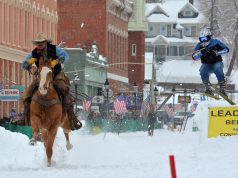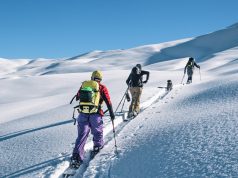
Chris Jarnot skis like you’d expect someone who has spent nearly all of his adult life working in the ski industry does: fast, fluid, no bobbles or unnecessary movements, legs together, turns carved. He’s smooth through all types of terrain, and as we lap broken powder snow through rolling glades off of Vail’s Chair 11, he’s chalking up one of approximately 70 days he’ll be on the mountain this season.
That number may pale compared to hard-core locals, but Jarnot is hard-core in a different way. The University of Colorado graduate — he was a member of the class of 1989 — is the top guy at Vail. His job title is chief operating officer of Vail, but that doesn’t come close to describing the complexity and intensity of the position, which also includes overseeing all of Beaver Creek’s operations. Jarnot could have the best job in skiing. But given the fact that Vail and Beaver Creek ski areas are part of a large, publicly held company (Vail Resorts) that comprises 10 mountains, 18 hotels, 106 restaurants, eight golf courses, 180 retail shops and more than 22,000 employees, and considering that Vail is the crown jewel of the brand, it’s also one of the toughest jobs in skiing.
“A lot of the time I ski, it is work-related,” admits Jarnot, who probably gets fewer days lapping powder on Chair 11 than he’d like, but who also says he can’t complain about the on-snow time that does come his way. Given the fact that Jarnot has spent all of his career with Vail Resorts, there’s no doubt that he’s scored plenty of epic days on the hill, even though the day I skied with him, we only ended up with time for four runs on a snowy afternoon with the holidays breathing down the back of our necks. The skiing is good, very good, and Jarnot jokes about the difficulties of testing the “product” as we take 11 back up for a final lap. The snow keeps coming down and the conditions get softer with every turn.
One of a handful of kids in his neighborhood, Jarnot grew up in Edwards. After high school he made the trek to Boulder, where he attended the University of Colorado, intending to major in finance. He strayed from that path when he discovered that he could get a degree in tourism management from CU’s business school. For a student who had been moonlighting as a ski instructor during the holidays back at Beaver Creek, it seemed like a perfect fit. Things got even better when he scored an internship in the marketing department at Vail. While the internship was required for graduation, the end result was even sweeter: At the end of the summer, Jarnot was hired by Vail’s advertising department. The year was 1989, and unbeknownst to him he was about to embark on a multi-year journey that would take him to the top of the organization.
There is a saying among Vail locals that they “came for the winter and stayed because of the summers.” That’s not entirely true in Jarnot’s case. His family has roots in the Vail Valley. His parents still live in the area, and his younger sister just returned to the area after a stint on the East Coast. But the flip side to sticking around a resort town like Vail is that year-round jobs — the kind of employment that makes it possible to enjoy the summer — can be hard to find. When Jarnot landed his gig in the advertising department, he scored, as he freely admits.
“I thought I’d spend the winter after my internship ski instructing,” says Jarnot.
Still, if you’re a CU student reading this, and you want to break into the ski industry, or maybe even pull a “Jarnot” and end up running a place like Vail, instructing isn’t a bad place to start. The opportunity to learn the mountain, interact with customers and be out there every day is invaluable, and it’s a path that Jarnot says can lead to good things, particularly if you’re hardworking and go the extra mile.
“We have a lot of well-educated, bright people who move to Vail for the season,” notes Jarnot. “If they excel, we look to them to fill our year-round positions.”
Vail and the rest of the Vail Resorts family have developed fairly sophisticated ways to track customer satisfaction with the ski area’s employees as well as on-the-job performance, he adds.
“I recommend that you come and work for us and differentiate yourself,” he says. “Take on more than you are assigned.”
Of course, at a place like Vail, there are a lot of opportunities to do just that. Not only in the positions that most people think of when considering heading to the mountains, jobs like lift operations, ski patrolling and instructing, but also those that are more behind the scenes, like grooming, terrain park-building and snow-making.
For Jarnot, who is in the hot seat when it comes to choreographing all these people, their departments and the rest of the infrastructure into a winter ballet that delivers effortlessly, there’s one time each year that always seems more special than the rest.
Surprisingly, it’s not opening day, when the lifts start to spin and another season starts on the mountain. Rather, it’s in the period immediately prior to when the mountain fires up for the season, when the new employees are arriving and they’re getting their first informational meetings with the guy at the top.
“One of my favorite things is getting to speak to all of our new employees each fall,” Jarnot says. “I’m envious of them because the time that they are about to have during the upcoming season is going to be an experience of a lifetime.”
The stoke and excitement of people who are about to spend a winter working at one of the best resorts in Colorado is energizing, says Jarnot. And, while most of them will only spend a couple seasons at the resort before moving on, there’s always the chance that one of them will stay for the summer, maybe move into a year-round position from that ski instructor gig, and end up one day finding themselves, miraculously and unexpectedly, at the top of the mountain, amazed and blessed that somehow they’ve ended up in the hot seat, running the whole damn show.
Respond: [email protected]














